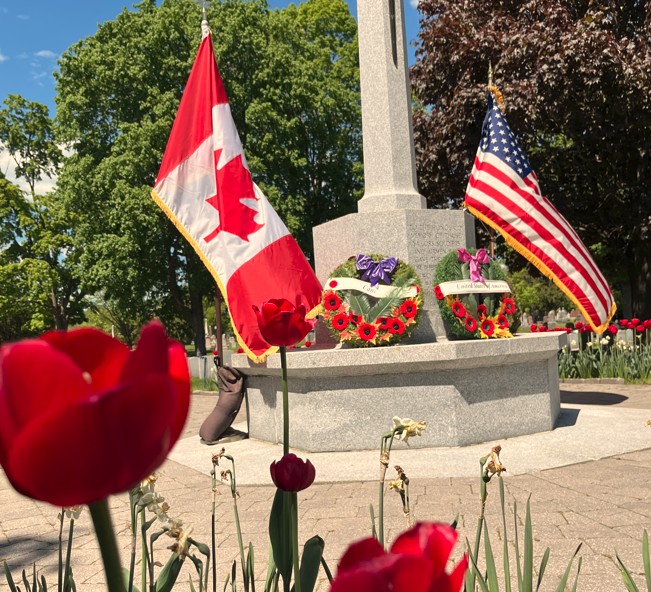
Honouring the Fallen, Beyond Borders - Memorial Day Ceremony at Beechwood Cemetery
On a bright May 27th afternoon, the Beechwood Cemetery Foundation and the National Military Cemetery of Canada came together with the U.S. Embassy and members of the diplomatic, defence, and veteran communities to mark U.S. Memorial Day — a solemn occasion on the sacred grounds of Canada’s national military resting place.
Honouring the Fallen, Beyond Borders
The ceremony opened with a land acknowledgement recognizing the unceded, unsurrendered Territory of the Anishinaabe Algonquin Nation. Nicolas McCarthy, Director of Marketing, Communications, and Community Outreach at Beechwood, welcomed guests and framed the importance of this gathering: to honour all American service members who paid the ultimate sacrifice both in Canadian Armed Forces and US Armed Forces in Canada, and to recognize the deep, historical bond between Canada and the United States, forged not only by treaties but by blood, duty, and shared values.
The Origins of Memorial Day
Memorial Day, originally known as Decoration Day, arose in the wake of the American Civil War — a conflict that claimed more lives than any other in U.S. history. In 1868, May 30th was designated as the day to lay flowers on the graves of fallen Union soldiers. Over time, this practice evolved into a national day of mourning for all American military personnel who died in service. While the day remains an American holiday, its meaning resonates far beyond U.S. borders — including here in Canada, where American servicemen lie at rest, side by side with Canadian comrades-in-arms. Americans in Canadian Uniforms:
A lesser-known but deeply significant chapter of military history was brought to the forefront during the ceremony: the tens of thousands of American citizens who chose to enlist in the Canadian Armed Forces during both World Wars.
Before the United States entered the First World War in 1917, over 35,000 Americans crossed into Canada to join the Canadian Expeditionary Force. Many felt compelled by moral conviction, a sense of duty, or outrage over atrocities abroad. These men fought at Ypres, the Somme, Vimy Ridge, and Passchendaele — names etched in Canadian memory, but carried too by these Americans who died wearing the maple leaf on their shoulder. Their sacrifices were not symbolic. They were real, and profound. Nearly 3,000 Americans in Canadian uniform lost their lives in the Great War. They are buried in cemeteries across France, Belgium, and here at home in Canada.
The same spirit of commitment continued during the Second World War. Prior to the U.S. entry into the conflict in December 1941, approximately 9,000 Americans had already enlisted in Canada. Over 800 joined the Royal Canadian Air Force, and flew in Bomber Command missions over Nazi-occupied Europe. They faced staggering odds, yet many persevered and served with distinction. Some were decorated for bravery. Others never made it home. Their names appear on cenotaphs and memorials throughout Canada. Some rest at Beechwood — buried not as foreigners, but as fellow warriors in a common cause.
Remarks from Distinguished Guests The ceremony continued with reflections from Marybeth Turner, Deputy Chief of Mission at the U.S. Embassy in Ottawa, and Major-General I.S. Huddleston, Deputy Vice Chief of the Defence Staff. Both paid tribute to the enduring alliance between the U.S. and Canada, shaped not only by treaties and trade but through trench lines, cockpit missions, and joint sacrifice.
The wreath-laying ceremony followed — a military tradition observed across generations and nations. Representing mourning, respect, and enduring remembrance, wreaths were laid by:
- Major-General I.S. Huddleston on behalf of Canada
- Deputy Chief Marybeth Turner and Colonel Chadwich Sterr for the United States
- Commander Mark Tapsell, RNZN, representing New Zealand and all international military attaches and honouring all those lost in shared service
Guests then stood in silence for the playing of Taps — the iconic 24-note bugle call, first played during the American Civil War, now used to mark final farewells to the fallen in ceremonies across the globe. Its notes echoed across the headstones, calling all to reflect.
A Walk Through a Shared Legacy
To conclude the ceremony, guests were invited to join a Guided Commemorative Walk across the Beechwood grounds. The walk featured five key sites tied to U.S.–Canada military cooperation:
- CWGC Ottawa Cremation Memorials, honouring American and Commonwealth personnel cremated and memorialized here
- British Commonwealth Air Training Plan Memorial, recognizing the thousands of U.S. airmen trained in Canada during WWII
- First Special Service Force gravesite, remembering the legendary U.S.–Canadian “Devil’s Brigade”
- Afghanistan War Fallen, highlighting 21st-century battlefield partnerships
- 9/11 Memorial, dedicated to the Canadians lost in the September 11 attacks — a space of shared grief and resilience
This year's U.S. Memorial Day ceremony at Beechwood was more than a moment of protocol — it was a reaffirmation of the bonds of brotherhood and shared ideals that transcend borders.
Whether standing beneath stars and stripes or a maple leaf, every fallen soldier remembered today gave their life in the pursuit of freedom. As guests departed, the message remained clear: Remembrance is not bound by nationality. It is defined by honour. And in places like Beechwood, where histories and legacies converge, that honour lives on.
Together, we remember. Together, we honour.

